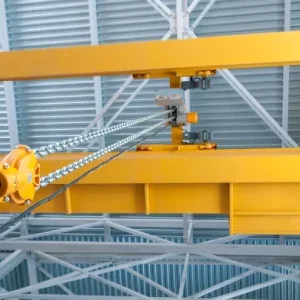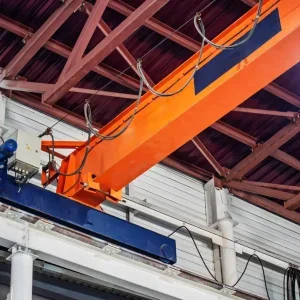Greater safety and power are among the advantages claimed for pneumatic hoists over their electric counterparts. But there are also disadvantages.
The largest number of hoist applications involve lifting loads of less than 3t on an infrequent basis over short distances and in dry, clean and safe environments such as the typical factory.
For such applications electric chain and wire rope hoists and cranes are the ideal solution. They are comparatively inexpensive, easy to install and require minimal maintenance.
However, there are many applications which preclude the use of electric hoists, either because suitable electrically powered hoisting machinery is not cost effective or because the electric option simply does not exist.
There are many standard features of pneumatic hoists which are not available in electric hoists, or which are available only with a high price penalty. However, the pneumatic hoist will never replace the electric hoist in all applications.
Advantages of air hoists
Progressive acceleration
Progressive acceleration enables the load to be lifted or lowered smoothly from rest up to the maximum speed dictated by the motor rating and gearbox reduction ratio. To achieve this with an electric motor the speed has to be varied by use of a frequency drive. These are usually expensive and bulky in construction.
Variable speed
The speed of a pneumatic motor is proportional to the flow of air through the motor at a given inlet pressure. The flow is a function of the orifice size of the control valve and the orifice size on the motor outlet port. If a control spool valve is fitted it may be operated progressively between the fully closed and fully opened position (either by regulating the pilot air pressure which opens the valve, or mechanically by means of control cords or chains connected directly to the spool). This controls the amount of air passing through the motor and hence its speed. By restricting the flow on the outlet port, the maximum attainable speed may be regulated. Incorporating a flow control valve enables the maximum operating speed to be selected by the user and adjusted on site.
Stall without damage
The ability to stall without damaging the motor is particularly useful where a resistance to movement in excess of the weight of the load to be lifted is predicted, for example when extracting a flange or freeing a seized item. Pneumatic hoists are designed so the stall load is less than the load which may cause mechanical or structural failure, hence the pneumatic hoist stalls safely. An electric motor, on the other hand, will rapidly overheat if it stalls. Thermal overload trip devices are commonly incorporated but these are activated by the increase in current drawn by the motor as a result of a rise in temperature. As a result, repeatedly stalling the motor, even if such devices are fitted, will ultimately damage the motor windings. Also, an overheated electric motor must be allowed to rest while the heat dissipates.
High usage rating
Provided it is properly lubricated, a pneumatic motor may be used continuously until a component part reaches the limit of its service life. This is a particular benefit in repetitive production applications where there is minimal recovery time between lifts or where extreme heights of lift are required. The most extreme example of this which we have recorded, was the lifting of a marine riser from the seabed to an oilfield production platform. The lift required two 12.5t pneumatic chain hoists lifting in tandem to 200m lift height and operating at slow speed. The operation lasted more than 24 hours. Later examination revealed no damage to the hoists and no measurable wear on the motor vanes.
Intrinsically safe
Compressed air is a safe medium. Hence without modification, air motors may safely be used in Zones 1 and 2 (DIN 57165). While heat is generated internally due to friction, provided the motor is internally lubricated as recommended by the manufacturer, the amount of heat generated will not pose a problem. In areas of significant hazard, nitrogen may be substituted for air as the operating medium. In Zone 1 environments additional precautions are taken in manufacturing the hoist. For example, aluminium alloys with a high magnesium content are avoided (an aluminium smear on steel decking is explosively combustible by impact) and precautions are taken to prevent contact with components which may contain iron oxide (rust) by plating such surfaces with phosphor bronze or copper or by utilising high chromium content (stainless) steels. While it is possible to manufacture electric hoists and controls suitable for such areas,they are expensive and cannot be maintained by electricians not in possession of the necessary approval to access the enclosures.
Power to weight ratio
Few manufacturers of electric chain hoists use motors in excess of 2kW due to the weight of larger motors. This effectively limits the range of capacities to 5t (one or two manufacturers produce larger electric hoists but most limit their range to 3t). Pneumatic vane motors are manufactured up to 9.5kW while pneumatic radial piston motors are available up to 23kW. Translated into terms of load this means major manufacturers can offer pneumatic hoists of 50t capacity or more.
Tolerates aggressive environments
A pneumatic motor does not require a cooling fan to dissipate the heat. Indeed when the air expands at the outlet manifold, the manifold is cooled. An electric motor on the other hand uses a fan to blow air over the motor in order to to cool it. The fan must be open to the atmosphere and hence water and contaminants can enter the fan housing.
Tolerates wet environments
Protection of electric motors against very wet atmospheres, e.g. on a ship’s decks, is achieved by dispensing with the cooling fan (IP56 – totally enclosed, non-ventilated). The downside of this is a reduction in duty rating caused by heat generation. The only points of entry to a pneumatic motor are the inlet, exhaust and breather ports. It is of necessity a sealed unit. Unless contaminants and/or moisture are delivered with the compressed air, they cannot enter the hoist.
Operational safety
When working in an exposed environment, such as a mine, shipyard or construction site, safety legislation dictates the type and voltage of electrical installations. No such restrictions exist with regard to pneumatic hoists. Provided that the supply hose is correctly rated (most pneumatic motors operate in the 4 to 6 Bar range) a pneumatic hoist may be used in any location and installed in minutes.
Hence the use of pneumatic hoists for exposed environments and in temporary installations is a viable and cost effective option.
Disadvantages of air hoists
Cost of standard equipment
Comparing pneumatic and electric hoists of smaller capacities (250kg to 5000kg) a pneumatic hoist costs approximately twice the price of an electric hoist. The primary reason is that electric hoists are produced in larger quantities by more manufacturers. Additionally they tend to incorporate mass produced components (motors, controls etc.) whose applications are not limited to electric hoists.
Higher running cost
A pneumatic hoist relies on a compressor (usually electrically or diesel powered) to produce the compressed air which powers the hoist. Not only is power wasted because of inherent inefficiencies within the compressor, but the compressor itself requires routine maintenance.
Pollution can be a problem
Clearly, if compressed air is lubricated prior to reaching the hoist then lubricant will be expelled with the exhaust air. Where this could be a problem (for example in food and pharmaceutical industries or in paint spraying), it is often necessary to pipe the exhaust away, depositing the airborne lubricant into the atmosphere in a safe area, or to remove the lubricant with a filter.
Maintenance requirement
Both electric and pneumatic hoists have similar inspection requirements and maintenance intervals, but the filter and lubricator units used with pneumatic hoists require frequent draining and topping up respectively. Failure to undertake such maintenance will result in rapid rates of wear in the motor components and failure due to internal corrosion. Unless the air quality and level of lubrication is maintained pneumatic hoists will prove unreliable.
More noisy
Electric hoists are relatively silent in operation. With pneumatic hoists noise is generated by expanding air at the outlet manifold. Modern pneumatic hoists are internally silenced and meet European noise level regulations. However, increased silencing tends to reduce the flow of air through the motor and increases the motor outlet pressure thereby reducing the efficiency of the hoist motor.
Complex and limited controls
With electric hoists there are no apparent delays in response to control instructions. Control gear components are inexpensive and compact as are complex control circuits, which are also easy to manufacture. On the other hand, the response times of pneumatic controls are related to the lengths of the control lines. Consideration must be given to the time delay in pressuring and de-pressurising control circuits. Control valves tend to be more expensive than electrical switch gear, more bulky and limited in application. Most of the limitations of pneumatic control circuitry may be overcome by incorporating low voltage or intrinsically safe electrical solenoid-type controls. Although available in intrinsically safe formats, these have not generally found favour with pneumatic hoist users.
In conclusion, pneumatic hoists exhibit many favourable operating characteristics which are either not possible to replicate or expensive and clumsy using electric hoists. But for reasons of convenience, pollution and price they will not replace the electric hoist as a basic factory lifting tool.






